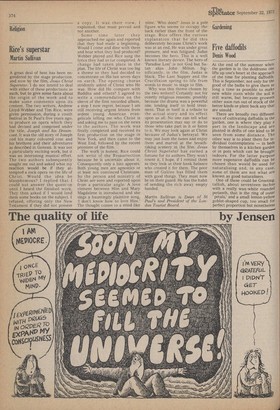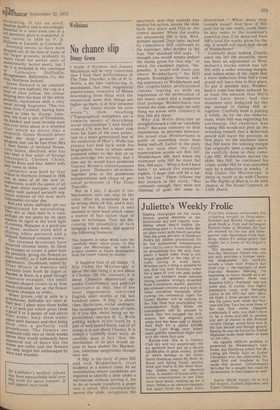Gardening
Five daffodils
Denis Wood
At the end of the summer when the garden is in the doldrums one lifts up one's heart at the approach of the time for planting daffodils. This is September, not only for the good of the bulbs to give them as long a time as possible to make 'new white roots while the soil is still warm, but because growers either soon run out of stock of the better kinds or plant back any that are unsold.
There are broadly two different ways of cultivating daffodils in the 'garden, one is where they play a part in the landscape and are planted in drifts of one kind to be seen from some distance. The other way is to plant them for individual contemplation — in beds by themselves in a kitchen garden or in pots which can be brought indoors. For the latter purpose more expensive daffodils can be chosen than would be used for naturalising and, in any case, some of them are not what are known as good naturalisers.
One of these could be Greeting, tallish, about seventeen inches with a really wax-white rounded perianth, that is the ring of outer petals,' and a small lemon-yellow goblet-shaped cup, too small for perfect proportion but nonetheless enchanting. It has an aloof, timeless quality and is exceedingly beautiful in a vase l even one in a tall specimen glass is wonderful. It was raised in 1939 by P. D. Williams at Lanarth in Cornwall.
Greeting seems to have been dropped out of the lists of many of the larger growers, probably to make room for newer ones of questionably better merit, but I see it is included in the catalogue
of Carncairn Daffodils, Broughshane, Ballymena, Co. Antrim, Northern Ireland. Green Howard is an unusual and novv rare daffodil, the cup is a kind of olive yellow, the colour straying into the base of the white Perianth, mysterious with a very sweet strong fragrance. This too Came from Cornwall, having been raised in 1944 by George Johntone, the d!rar sc uire of Trewit hen, the kindest and most lovable man that ever went about in a wheeled Chair which he drove like a Projectile. Green Howard never made the large growers' catalogues, but can be had from Mrs J. Abel Smith of Orchard House, Letty Green, Hertford, who has also kept a few other of George J„ohnstone's, Chelsea China, rarnille Rose and Ann Abbot with Pink tones in them. Cantatrice was bred by Guy Wilson in Northern Ireland in 1936 and in spite of all the new introductions, is still the queen of all the pure white trumpets, tall and stately with pointed perianth segrents instead of the now more ashionable circular disc. Red and white daffodils are too .,,,s°,Phisticated for naturalising. 'ney are at their best in a vase, Perhaps on the piano by an open window In April in the level light (if evening. Matapan is a good one of these, medium sized with a shining white perianth and a brilliant flattened crimson crown.
The reversed bi-colours have attracted interest lately. In these itle trumpet or crown is paler than
t "le perianth, giving the flowers an Otherworldly, as if half-bewitched, ,aPPearance. Daydream, raised by ‘'rant Mitsch in America and available here from de Jager at Marden in Kent, is a good though expensive example, the small In-II/Met-shaped crown is at first le/non-coloured, but as the flower matures changes to white. When grown cold in pots in a greenhouse, daffodils are seen at their best. I plant mine three bulbs in a 12 inch pot which gives them 4 good 3 or 4 inches of soil above their noses, bury them under ashes until January and then bring them into a perfectly cold greenhouse. The flowers are Produced only two or three weeks before they would ordinarily have aPPeared out of doors but the stems are taller and the flowers not only larger but undamaged by wind and weather.



































 Previous page
Previous page